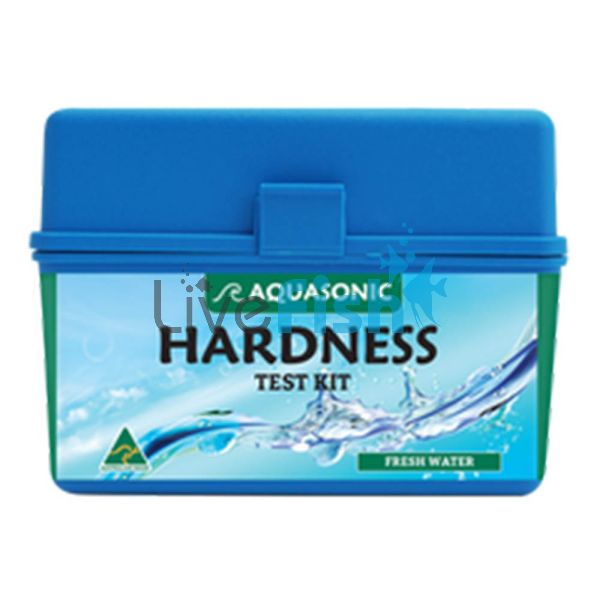Aquasonic Hardness (GH) Test Kit
This HARDNESS TEST KIT measures the sum of the calcium and magnesium concentrations, expressed in ppm (parts per million). This is, in essence, a measurement of the permanent hardness of water, but the measurement may also contain some temporary hardness in the form of calcium dissolved by carbon dioxide in water. This form of temporary hardness is usually minimal.
ADJUSTING HARDNESS
-
To reduce hardness use a WATER SOFTENING KIT.
-
To raise hardness Aquasonic makes a range of products that raise hardness by controllable amounts to suit specific fish species.
-
GOLDFISH WATER CONDITIONER Raises hardness by 120ppm.
-
TROPICAL WATER CONDITIONER Raises hardness by 80ppm.
-
LIVEBEARER WATER CONDITIONER Raises hardness by 110ppm.
-
RIFT LAKE WATER CONDITIONER Raises hardness by 300ppm.
-
CARBONATE HARDNESS GENERATOR 5g per 100L Raises hardness by 20ppm
HARDNESS TEST KIT
This HARDNESS TEST KIT measures the sum of the calcium and magnesium concentrations, expressed in ppm (parts per million). This is, in essence, a measurement of the permanent hardness of water, but the measurement may also contain some temporary hardness in the form of calcium dissolved by carbon dioxide in water. This form of temporary hardness is usually minimal.
HOW DOES WATER BECOME HARD?
Water hardness results from dissolved compounds of magnesium and calcium. With temporary hardness, magnesium and calcium are dissolved by carbon dioxide in water. This process can be reversed by removing the carbon dioxide, e.g. By boiling, or as aquatic plants use carbon dioxide. However, if the salts of magnesium or calcium are dissolved as a result of acid present in water, the hardness becomes permanent.
WATER HARDNESS IN THE NATURAL STATE
The degree of hardness varies not only from country to country but river to river and even the hardness in each river varies from season to season. Aquatic life has different requirements according to geographical location and though most fish can stand a great deal of variation in hardness, they do best at specific levels. Factors like the breeding of a species, the colour of a species, or even the inhibition of fungal diseases can be greatly enhanced by the hardness of the water.
SPECIES REQUIREMENTS
Examples of fish that live at or below 150ppm are Angels, Corydoras, Catfish, Discus, Gouramis, Loaches, and South American Tetras. Examples of fish that live between 150ppm and 300ppm are some Australian Natives, Guppies, Sword Tails, Mollies, Platties, and Goldfish. Examples of fish living above 300ppm and usually under 500ppm are African Cichlids and Brackish water species.
COLOUR CHART DIRECTIONS FOR USE
The test kit has a dual range, measurements can be made in steps of 10ppm or 20ppm (ppm = parts per million).
Complete the test within 5 minutes.
TO TEST IN 10ppm STEPS
- Rinse a clean test tube several times in the water to be tested and filled to the 10ml mark.
- Add 3 drops of Reagent 1, swirl to mix, then add 3 drops of Reagent 2 and swirl to mix.
- Now add Reagent 3 (hold the bottle vertically), a drop at once a time, and swirl to mix before adding the next drop. Keep count of the drops. When the colour changes from red to blue the endpoint has been reached. Multiply the number of drops by 10 for the reading in parts per million.
TO TEST IN 20ppm STEPS
-
Rinse a clean test tube several times in the water to be tested and filled to the 5ml mark.
- Add 2 drops of Reagent 1, swirl to mix, then add 2 drops of Reagent 2 and swirl to mix.
- Now add Reagent 3 (hold the bottle vertically), a drop at a time, and swirl to mix before adding the next drop. Keep count of the drops. When the colour changes from red to blue the endpoint has been reached. Multiply the number of drops by 20 for the reading in parts per million.
NOTE:
- Place the test tube on the white background of the colour chart, and view it vertically with the light behind you. The colour in the test tube is best viewed with natural light.
- Colour of the test sample may vary slightly with different interfering agents from aquarium water.
- At the first colour change, the endpoint has been reached.
- To convert ppm to (German) dH, multiply by 0.056. 1odH (German) equals 17.85ppm calcium carbonate.
*This colour chart provides a basic guide only. Colours may vary according to various water conditions.
| Scientific Name | (GH) Test Kit |
|---|




